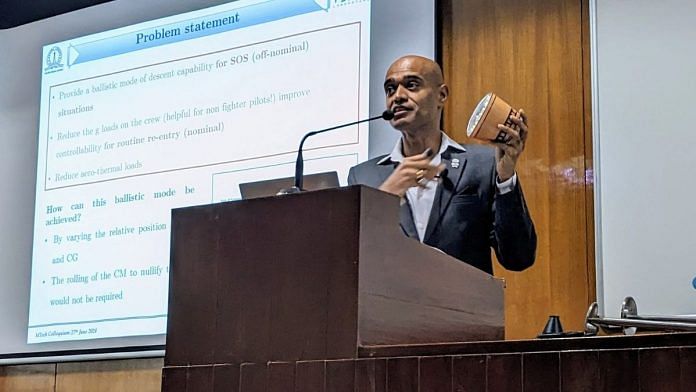New Delhi: After being a test pilot and one of India’s astronaut-designates for its first human spaceflight Gaganyaan, Indian Air Force Group Captain Prasanth Nair may now have provided a solution to one of the biggest challenges faced by space missions the world over.
Nair has carried out extensive research on ‘Inflatable Aerodynamic Decelerators in Space Re-entry Vehicles in hypersonic regime’ as part of his Master’s degree which he has just been awarded by Bengaluru’s Indian Institute of Science (IISc).
“I received my MTech (Research) from the prestigious Indian Institute of Science (IISc), Bengaluru, from its director,” Nair posted on his X handle Tuesday.
Nair’s research focussed on a design for a re-entry capsule, a balloon-like device that opens at the front, making the entry of a spacecraft back into Earth’s atmosphere smoother, safer, and more controlled.
Nair’s work is significant in what it means to space travel. His design for the capsule, thought still a concept, would make space travel easier for untrained civilians. It’s still in the concept phase, but if approved and scaled up, the technology opens the door to space tourism in India.
The technology
During space missions, spacecraft tend to move at hypersonic speeds—much faster than the speed of sound.
During this process, immense heat and pressure are generated due to the friction between air molecules. The challenge is to control these conditions while ensuring the craft and its inmates are safe. The re-entry of capsules into the Earth’s atmosphere is considered one of the most challenging parts of a space mission. One wrong move could blow up the craft and everyone inside.
Nair’s design for the Inflatable Aerodynamic Decelerator (IAD) is likely reduce decelerating G-forces significantly. In simpler terms, this device will enable the spacecraft to re-enter the Earth’s atmosphere smoothly, with better control.
India’s own Gaganyaan crew module, which is slated for launch in the first quarter of 2027, is a classic crew module design. This traditional design generates a lot of aerodynamic drag—the force that opposes the motion of an object through air—as it enters the Earth’s atmosphere to slow it down.
With the IAD, the lift-to-drag ratio of the craft can be significantly altered by changing its centre of gravity. This allows for a controlled descent trajectory. So, the space ride might take longer, but it will be a smoother ride with a more controlled descent.
The peak G-loading for this design will not exceed 1g, as opposed to the current Gaganyaan capsule, which has a peak g-loading of approximately 3.5-4g.
G-loading is the amount of gravitational pressure on a body. The greater this pressure, the greater would be the friction of the object with air, and the rougher the ride would be upon atmospheric entry.
(Edited by Viny Mishra)
Also read: IISc scientists have cracked the code for Earth landing. India’s gearing up for space tourism






